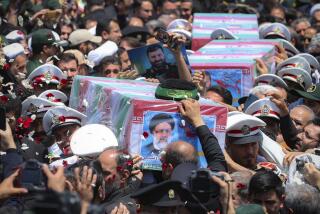Poor Iranians Flock to Khomeini’s Tomb
- Share via
TEHRAN — After Friday prayers, the religious high point of the Iranian week, a favorite excursion is to the air-conditioned tomb of Ayatollah Ruhollah Khomeini, founder of the Islamic republic.
It is especially popular with the poor, the vast majority of Tehran’s 10 million people, because of the free bus to the shrine outside the Behesht-e Zara cemetery, 10 miles south of the city.
The tomb is a huge, impressive example of traditional Islamic architecture, with a gilded cupola that glistens in the sun. The complex housing the shrine covers 50 acres and is still under construction more than two years after Khomeini, known as “the Imam,” died of cancer in June, 1989.
Khomeini’s tomb overlooks a vast cemetery. In the burial ground lie tens of thousands of his supporters slain in the revolution that overthrew Shah Mohammed Reza Pahlavi in 1979, soldiers killed in the Iran-Iraq war of 1980-88 and thousands of people executed for opposing Khomeini.
Westerners may be surprised by the carnival atmosphere. Children shriek merrily as they slide over a marble floor the size of a football field. Families have picnics on precious Persian carpets under giant chandeliers donated by the faithful.
Traffic in Tehran is a nightmare. It always was bad, even before the revolution, but now seems worse than even Rome or Paris, despite efforts to limit access to the downtown area.
On a Friday, the Muslim Sabbath, five lanes of cars moved uphill at pedestrian speed, filled with people trying to escape what official media have described as the world’s most polluted city.
A motorbike carrying a father and three children precariously balanced behind him threaded through the bumper-to-bumper traffic. A cabbie boasted:
“My brother manages to get five on his bike--himself, his three kids and his wife. That’s OK in summer. But in winter there’s ice on the street and they risk breaking their necks.”
A woman clad in a long black chador and riding a motor scooter also passed the fuming drivers.
“That’s really dangerous,” the cab driver said. “Several women have been killed when their chadors got caught in the wheels.”
Two million vehicles clog Tehran every day, their exhaust fumes adding to smog that seems like a permanent shroud. The daily Reselat estimated that residents of Tehran waste 1.2 billion hours a year trapped in traffic jams, “the equivalent of 43,237 years.”
More than a decade after the U.S. Embassy hostage drama, more Westerners with hard currency are visiting Iran, which has enormous economic problems.
President Hashemi Rafsanjani, despite opposition from anti-Western fundamentalists, is striving to encourage Western firms to invest in Iran.
Whatever their view of investment, the fundamentalists are not above making a dollar or two out of the faranghi , or foreigners.
“For rent or sale only to European or American families,” said a real estate agency ad in the daily Kayhan, generally considered the voice of hard-liners who still call the United States the “Great Satan.”
A Western businessman can choose from scores of villas in northern Tehran at the foot of the Alborz Mountains, where the revolutionary elite now occupy mansions built by the late shah’s courtiers.
Monthly rent for a three-bedroom mansion with servants’ quarters, garden and swimming pool is advertised as about $3,000.
“But that’s negotiable,” Salman Ganji of the Robinson Agency hastened to add.
More to Read
Sign up for Essential California
The most important California stories and recommendations in your inbox every morning.
You may occasionally receive promotional content from the Los Angeles Times.













